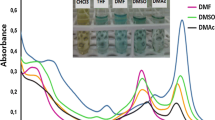Summary
The constitution (V) proposed by Fierz-David for Hydron Blue, in which polymerisation of the thiazine from carbazole-indophenol through disulphoxide linkages is postulated, does not take into account the necessity of polymerisation through the positions marked by asterisks in (V) to account for the dyeing property of Hydron Blue. The fact that polymerisation of thionated carbazole-indophenol units does not proceed through carboncarbon linkages has been proved by the identity of the reduction products from carbazole-indophenol and from Hydron Blue, obtained by treatment with Raney nickel. The formation of the glycollic acid (XVIII) from the thiazone (XV) indicates the possibility of reaction between the phenolic groups in leuco-Hydron Blue and chloracetic acid. If disulphoxide linkages were present in Hydron Blue (V) and its analogues, such as Pyrogen Indigo (IV), the condensation of their leuco-derivatives with chloracetic acid should have given tetra-acetic acid derivatives corresponding to the two thiol and the two phenolic groups in their leuco-compounds (e.g., XXII). Fierz-David, however, obtained a diacetic acid derivative from Pyrogen Indigo. Taking these facts into consideration, the constitution (XIII) is now proposed for Hydron Blue, in which polymerisation of thionated carbazole-indophenol units through sulphoxide linkages is postulated. Other analogous sulphurised indophenols can also be similarly constituted. The new constitution for sulphurised indophenol dyes readily accounts for the formation of a diacetic acid derivative from Pyrogen Indigo on the basis of the reaction between chloracetic acid and the phenolic groups in leuco-Pyrogen Indigo as in the case of the simple thiazone (XV).
Similar content being viewed by others
References
RoweJ. Soc. Dyers Col., 1917,33, 9.
Ghosh and ShahChemical Industries, National Planning Comm. (Vora & Co.), p. 86.
Meyenberg and LevyRev. gen. Mat. Col., 1902, 212.
Gnehm and KauflerBer., 1904,37, 2618, 3032.
WeinbergIbid.,, 1930,63, 117.
Fierz-David,et al. Helv. Chem. Acta., 1932,15, 287,et sequa.
—J. Soc. Dyers Col., 1935,51, 50.
HerzU. S. P. 1, 699, 432.
Shibata and NishiJ. Chem. Ind. Japan, 1935,38, Suppl. 41.
Fierz-DavidKünstliche Organische Farbstoffe, Ergänzungsband (Springer), 1935, 26.
FrankJ. Chem. Soc., 1910,97, 2047.
KulikovTrans. Leningrad Chem. Techn. Inst., 1934,1, 149 (C. A., 1935,29, 2747).
Author information
Authors and Affiliations
Rights and permissions
About this article
Cite this article
Shah, K.H., Tilak, B.D. & Venkataraman, K. Sulphur dyes and sulphurised vat dyes. Proc. Indian Acad. Sci. (Math. Sci.) 28, 111 (1948). https://doi.org/10.1007/BF03170782
Received:
DOI: https://doi.org/10.1007/BF03170782



